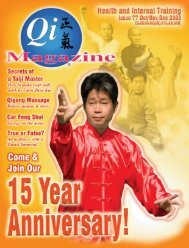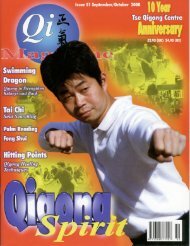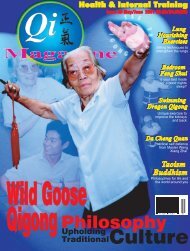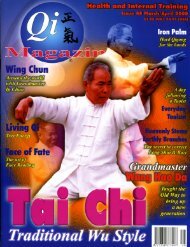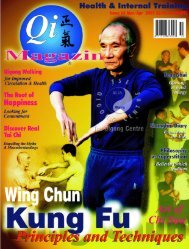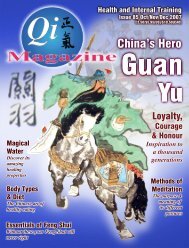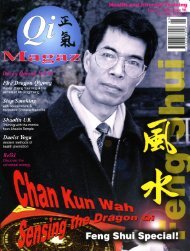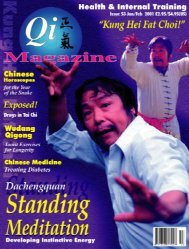Issue 49 - Tse Qigong Centre
Issue 49 - Tse Qigong Centre
Issue 49 - Tse Qigong Centre
- No tags were found...
Create successful ePaper yourself
Turn your PDF publications into a flip-book with our unique Google optimized e-Paper software.
and at that moment a rare ray of sunlight bounces off the goldenBuddha, surrounded by white and peach-coloured carnations,highlights the drifting incense smoke and the patiently waitingfigures. The whole scene is suddenly transformed into somethingmagical. Purpose and optimism returns with that moment. As ifreading my mind the Ajahn brings the retreat into context. It’sonly a little time to reflect compared to the vast amount of timewe’ve spent creating and nurturing our mental and emotionalhabits. He uses the analogy of a vast ship like an oil tanker. Eventhough the captain rings the engine roomand the motors are cut, it’s still sometime, some distance, before the shipactually slows and stops. We’vestarted the work on this retreat, theengines are slowing. Now we haveto be patient and wait for results.As it’s an observance daythere’ll be no afternoon orevening meal today. AjahnJutindharo has to join othermonks in the temple tochant the Vinaya(monastic precepts).However, we do get to dosome basic qigongstretching and breathingwith Venerable Sacciko.It’s all very simple stuff,nowhere near the qualityI’m used to enjoying with<strong>Tse</strong> Sifu, but it’s entirelyappropriate for thisoccasion. I’m a bit miffedat not being able to goround the roomcorrecting people’sposture, though! Iconsole myself with apre-dawn trainingsession in the field thenext morning. It’s verysilent and I realise I canhear frogs croaking inthe long wet grass, like tiny motorbikes revving up.Sunday lunchtime arrives. The volunteer filling VenerableSacciko’s alms bowl has been a little over-enthusiastic with thebean sprout and watercress salad and it’s hanging over the edgeof the bowl like some luxuriant pot plant. Sacciko knows there’sno room for the chocolate pudding but he’s shaking his head andlaughing...One evening, the Ajahn has offered a dasana (dhammatalk). Before he commences I distinctly hear the words ”The fivehindrances” spoken aloud in my head so it’s no surprise that thisdoes indeed turn out to be the topic for the evening. The fivehindrances or obstacles to spiritual practice are dullness,restlessness, doubt, aversion and attachment. I’m loaded with allthose so the talk should do me good!In meditation, as in daily life, we encounter these obstaclesconstantly. We often use dullness or restlessness to avoid actuallyexperiencing a situation, such as having to communicate withsomeone profoundly boring. We either want to fall asleep or westart fidgeting. However, we often employ these two obstacles orunskilful mental states to cover up or avoid deeper problems anddissatisfactions. Anyone who’s unhappy with their job or arelationship will experience lack of energy or too much of it, dueto dullness or restlessness. They are also likely to see-sawbackwards and forwards between aversion and attachment –”Don’t want this, I want that.” ”Don’t like this food, this person,this job, this jacket, this teacher, I would rather have that kindinstead.”Some of the time this picking and choosing is fairly banalbut it does further condition us and makes our happiness andwellbeing more and more dependent on certain conditions beingfulfilled. We need more and more ideal conditions before we feelthat things are just right. But that ”just right” never happens, sowe keep trying to change the conditions instead of our reactionto them. A correct balance between the acceptance of asituation and the changing of it is more likely to be of longerlasting benefit than always trying to find the ideal conditionsto marry, to train, to retire etc. If we go down that”external” road we’re going to create more sufferingfor ourselves, The Ajahn reminds us of the centralpremise of Buddhism, ”Suffering is to beinvestigated and understood.”As he speaks I’m remindedof something Ajahn Sumedho, theAbbot of Amaravati said once.Using his customaryunderstatement, he told us of atime in the jungles of Thailandwhen he was living on top of amountain to meditate insolitude. Eventually, throughsome kind of animal or insectbite he developed an infectedleg (which still troubles him tothis day). Apparentlyhe often used to enda meditation sessioncovered in bees,who seemed to likethe taste of hissweat. Anyway,the leg got worsebut he refused alloffers of help untila nearby temple employed some villagers to forcibly carrySumedho, who was quite ill by now, down the mountain to theirvillage. Unfortunately they placed him in a small hut with acorrugated iron roof and over the next few days Sumedho wasalternately baked and frozen every day and night. His fever gotworse and flies would block his nose and mouth every time hebreathed. ”It was at this point,” Sumedho said smilingly, ”That Irealised I had a complaining mind.” He decided to ”stop feelingsorry for himself’ and crawled out of the hut to resume hismeditation practice. No matter the man’s a legend!What Sumedho was saying there, and what Jutindharo wasconfirming, was that we create so many problems for ourselvesby falling prey to greed, hatred and delusion in so many ways,both subtle and gross. A little bit of detachment, clarity andgentleness go a long way towards freeing ourselves from our selfcreatedconditions. I realise how lucky I am to have qigong tohelp my body, meditation to help my mind and Buddhism andsome wonderful friends to help my heart. The retreat is turningout to be a productive time after allby Julian WildeQi Magazine 43



